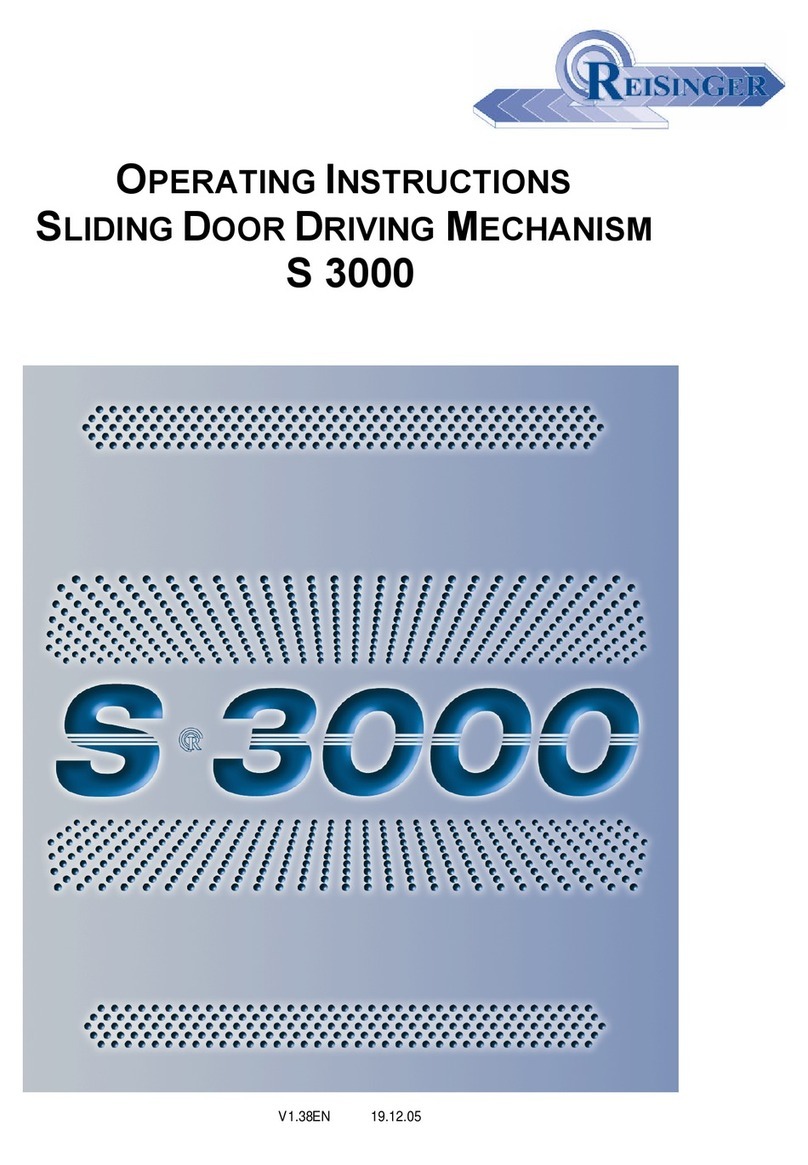6.0 Features
All licensed control elements such as push-buttons, light
barriers, dynamic pressure switches, code keyboard, mo-
tion sensors etc. can be connected.
Keep all parts of the body away from any mov-
ing parts. Be extremely careful within the
range of the driving unit!
6.1 Standard feature
Push-button for complete opening 1 (COMPLETE 1
[4,5])
The sliding door opens completely and closes automatic-
ally a ter a preset time period.
Push-button for partial opening (PARTLY [6,7])
The sliding door opens partly and closes automatically
a ter a preset time period.
Push-button/switch for permanent opening (PER -
MANENT [8,9])
The sliding door opens completely and closes only a ter
a push-button or the switch having been pressed anew.
Special input (SI [25,26])
Input or special applications (see parameter 51)
Lock/limit switch (KEY [27,28])
All control elements are deactivated. This is necessary
or a mechanic lock.
Wall-mounted rubber contact strip (COMPLETE 2
[29,30] )
The sliding door opens completely and closes automatic-
ally a ter the preset time period.
6.2 ptional Features
n request the following optional Extras can
be enabled by modules.
Internal interlocking function (RS485 [14,15]) module3
Two or more S4000 driving mechanisms can be mutually
interlocked. As soon as one door is open/opened, the
locking monitoring device will prevent another door be-
longing to the interlock rom being opened.
A signal (visual/audible) o the interlock state via LOCrt+
[terminal 55,65] (interlocked) and LOCgn+ [terminal
56,65] (unlocked) is possible.
External interlocking function (K1/LOC [10,11/12,13] )
module 3
A mutual interlocking with an external door is possible.
As soon as one door is open/opened, the locking monit-
oring device will prevent another door belonging to the in-
terlock rom being opened.
A signalling (optical/acoustic) o the interlock state via
LOCrt+ [terminal 55,65] (interlocked) and LOCgn+ [ter-
minal 56,65] (unlocked) is possible.
The max. total out put current of the switch-
able outputs CHK1/2, LOC rt+, LOC gn+ is
0.4A, maximum voltage is 24V DC.
Motion sensor (MS I / MS O [31-38]) module 1
Automatic opening o the door when an object is detected
by the motion sensor/s. The door closes according to the
preset stand open time.
Magnetic break (MB [44,45])
For special uses e.g. naval architecture.
Potential equalisation
Potential equalisation by sliding contact.
ther optional connections
Code keyboard, remote control, non-contact push-button,
terminal, notebook, PC, ault detector identi ication etc.
6.3 Safety features
Electronic reversion
In both motion directions, the reversing orce is preset to
less than 150 N (static)?.
I the door wing runs into an obstacle during its clos-
ing run, the door will reverse into PEN direction.
A ter a separately adjustable time (parameter 5) the
door closes again. I the obstacle is not removed, this
process will be repeated up to 3 times (adjustable by
parameter 36). A ter that the door will remain open,
until any key is pressed.
I the door wing runs into an obstacle during its open-
ing run, the door will stop and carry out the selected
unction in this position.
Safety element/s (LI 1/ LI 2 [61-66]) module 2
An additional protection o the closing zone:
The activated sa ety element causes the door wing to
reverse immediately by detection o obstacles.
An additional protection o the opening zone (LI 2 [61-
62]):This sa ety unction is laid out with multiple levels
has an audible signal and causes on an active sa ety
element and opening impulse.
1. on a closed door, opening movement o 400 mm
with low-speed and a terwards execution o the re-
spective opening unction.
2. on a currently opening door, the immediate stop or
a slow-speed drive until 400 mm and a ter wards ex-
ecutes the respective opening unction.
Emergency opening in case of power failure without
emergency module
Manual emergency opening o the door in case o a power
ailure is easily possible (<50N), as there is no “sel lock-
ing”.
Emergency module (ACCU [Y-adapter]) module 5
In case o a power ailure, the door can be opened/closed
approx. 50 times within one hour during normal opera-
tion. (Special eatures see parameter 82).
Maximum service life of accumulator modules
according to manufacturer is 4 years. The accu-
mulator must be replaced in a two- to four-year inter-
val during a safety check.
Lead-gel-accumulators self-discharge during
storage. In order to prevent permanent damages
(total discharge) you must recharge the accumulators
at least every 3 months!
You can order adequate chargers directly from
Reisinger GmbH.
VEN
– 7 –




























